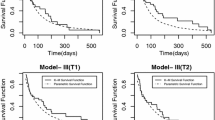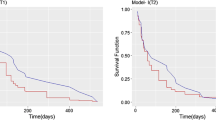Abstract
Frailty models are used in the survival analysis to account for the unobserved heterogeneity in individual risks to disease and death. To analyze the bivariate data on related survival times (e.g., matched pairs experiment, twin or family data), the shared frailty models were suggested. These models are based on the assumption that frailty acts multiplicatively to hazard rate. In this paper, we assume that frailty acts additively to hazard rate. We introduce the positive stable shared frailty models with three different baseline distributions namely, the generalized log-logistic and the generalized Weibull distributions. We introduce the Bayesian estimation procedure using Markov Chain Monte Carlo (MCMC) technique to estimate the parameters involved in these models. We apply these models to a real-life bivariate survival data set of McGilchrist and Aisbett (Biometrics 47:461–466, 1991) related to the kidney infection data and a better model is suggested for the data.
Similar content being viewed by others
Change history
15 June 2023
This article has been retracted. Please see the Retraction Notice for more detail: https://doi.org/10.1007/s12561-023-09380-y
References
Cox DR (1972) Regression models and life tables (with discussion). J R Stat Soc Ser B 34:187–220
Vaupel JW, Manton KG, Stallaed E (1979) The impact of heterogeneity in individual frailty on the dynamics of mortality. Demography 16:439–454
Clayton’s DG (1978) A model for association in bivariate life tables and its applications to epidemiological studies of familial tendency in chronic disease incidence. Biometrica 65:141–151
Oakes D (1982) A model for association in bivariate survival data. J R Stat Soc B 44:414–422
Clayton DG, Cuzick J (1985) Multivariate generalizations of the proportional hazards model (with discussion). J R Stat Soc Ser A 148:82–117
Crowder M (1985) A distributional model for repeated failure time measurements. J R Stat Soc Ser B 47:447–452
Hougaard P (1986) A class of multivariate failure time distributions. Biometrika 73:671–678
Hougard P (1987) Modelling multivariate survival. Scand J Stat 14(4):291–304
Oakes D (1989) Bivariate survival models induced by frailties. J Am Stat Assoc 84(406):487–493
Genest C, Mackay J (1986) Joy of copulas: bivariate distributions with uniform marginals. Am Stat 40(4):280–283
Vaupel JW (1991a) Relatives’ risks: frailty models of life history data. Theor Popul Biol 37(1):220–234
Vaupel JW (1991b) Kindred lifetimes: frailty models in population genetics. In: Adams J et al (eds) Convergent questions in genetics and demography. Oxford University Press, Oxford, pp 155–170
Vaupel JW, Yashin AI, Hauge M, Harvald B, Holm N, Liang X (1991) Survival analysis in genetics: Danish twins data applied to gerontological question. In: Klein JP, Goel PK (eds) Survival analysis: state of the art. Kluwer Academic Publisher, Dordrecht, pp 121–138
Vaupel JW, Yashin AI, Hauge M, Harvald B, Holm N, Liang X (1992) Strategies of modelling genetics in survival analysis. What can we learn from twins data? Paper presented on PAA meeting in Denver, CO, April 30-May 2, 1992
Nielsen GG, Gill RD, Andersen PK, Sorensen TIA (1992) A counting process approach to maximum likelihood estimation in frailty models. Scand J Stat 19:25–43
Hanagal DD (2005) A positive stable frailty regression model in bivariate survival data. J Indian Soc Probab Stat 9:35–44
Marshall AW, Olkin I (1967) A multivariate distribution. J Am Stat Assoc 62:30–44
Hanagal DD (2006) A gamma frailty regression model in bivariate survival data. IAPQR Trans 31:73–83
Hanagal DD (2007) Gamma frailty regression models in mixture distributions. Econ Qual Control 22(2):295–302
Hanagal DD (2010) Modeling heterogeneity for bivariate survival data by the compound Poisson distribution with random scale. Stat Probab Lett 80:1781–1790
Hanagal DD, Pandey A (2014) Inverse Gaussian shared frailty for modeling kidney infection data. Adv Reliab 1:1–14
Hanagal DD, Pandey A (2015a) Gamma frailty models for bivarivate survival data. J Stat Comput Simul 85(15):3172–3189
Hanagal DD, Sharma R (2013) Analysis of diabetic retinopathy data using shared inverse Gaussian frailty model. Model Assist Stat Appl 8:103–119
Hanagal DD, Sharma R (2015) Analysis of bivariate survival data using shared inverse Gaussian frailty model. Commun Stat Theory Methods 44(7):1351–1380
Hanagal DD, Bhambure SM (2014a) Shared inverse Gaussian frailty model based on reversed hazard rate for modeling Australian twin data. J Indian Soc Probab Stat 15:9–37
Hanagal DD, Bhambure SM (2016) Modeling bivariate survival data using shared inverse Gaussian frailty model. Commun Stat Theory Methods 45(17):4969–4987
Hanagal DD, Pandey A (2015b) Inverse Gaussian shared frailty models with generalized exponential and generalized inverted exponential as baseline distributions. J Data Sci 13(2):569–602
Hanagal DD, Pandey A (2016a) Inverse Gaussian shared frailty models based on reversed hazard rate. Model Assist Stat Appl 11:137–151
Hanagal DD, Pandey A (2017a) Correlated gamma frailty models for bivariate survival data based on reversed hazard rate. Int J Data Sci 2(4):301–324
Hanagal DD, Pandey A, Ganguly A (2017) Correlated gamma frailty models for bivariate survival data. Commun Stat Simul Comput 46(5):3627–3644
Hanagal DD, Pandey A (2016b) Shared gamma frailty models based on additive hazards. J Indian Soc Probab Stat 17(2):161–184
Hanagal DD, Pandey A (2017b) Shared inverse Gaussian frailty models based on additive hazards. Commun Stat Theory Methods 46(22):11143–11162
Hanagal DD (2011) Modeling survival data using frailty models. Chapman & Hall/CRC, Boca Rotan
Hanagal DD (2017) Frailty models in public health. In: Rao ASRS, Pyne S, Rao CR (eds) Handbook of statistics, vol 37(B). Elsevier Publishers, Amsterdam, pp 209–247
Hanagal DD (2019) Modeling survival data using frailty models, 2nd edn. Springer, Singapore
Lin DY, Ying Z (1994) Semiparametric analysis of the additive risk model. Biometrika 81(1):61–71
Bin H (2010) Additive hazards model with time-varying regression coefficients. Acta Math Sci 30B(4):1318–1326
Hosmer DW, Royston P (2002) Using Aalen’s linear hazards model to investigate time-varying effects in the proportional hazards regression model. Strata J 2(4):331–350
O’Neill TJ (1986) Inconsistency of misspecified proportional hazards model. Stat Probab Lett 4:219–222
Yin G, Cai J (2004) Additive hazards model with multivariate failure time data. Biometrika 91(4):801–818
Xie X, Strickler HD, Xue X (2013) Additive hazard regression models: an application to the natural history of human papillomavirus. Comput Math Methods Med 2013:1–7
Vahidpour M (2016). Cure rate models. Ph.D. dissertation, Ecole Polytechnique de Montreal
Nelson W (1982) Applied life data analysis. Wiley, New York
Boag JW (1949) Maximum likelihood estimates of the proportion of patients cured by cancer therapy. J R Stat Soc B 11:15–53
Aalen OO (1980) A model for non-parametric regression analysis of counting processes. Lect Not Stat 2:1–25
Aalen OO (1989) A linear regression model for the analysis of lifetimes. Stat Med 8(8):907–925
Shih JH (1998) A goodness-of-fit test for association in a bivariate survival model. Biometrika 85:189–200
Glidden DV (1999) Checking the adequacy of the gamma frailty model for multivariate failure times. Biometrika 86:381–94
Fan JJ, Hsu L, Prentice RL (2000) Dependence estimation over a finite bivariate failure region. Lifetime Data Anal 6:343–55
Hougaard P (2000) Analysis of multivariate survival data. Springer, New York
Fine JP, Glidden DV, Lee KE (2003) A simple estimator for a shared frailty regression model. J R Stat Soc B 65:317–329
Hanagl DD, Bhambure SM (2014b) Analysis of kidney infection data using shared positive stable frailty models. Adv Reliab 1:21–39
Hanagal DD, Kamble AT (2014) Bayesian estimation in shared positive stable frailty models. J Data Sci 13:615–640
Hanagal DD, Bhambure SM (2017) Modeling Australian twin data using shared positive stable frailty models based on reversed hazard rate. Commun Stat Theory Methods 46(8):3754–3771
Bacon RW (1993) A note on the use of the log-logistic functional form for modeling saturation effects. Oxf Bull Econ Stat 55:355–361
Deshpande JV, Purohit SG (2006) Life time data: statistical models and methods. World Scientific, New Jersey
Govind MS, Srivastava DK (1993) Exponentiated Weibull family for analyzing bathtub failure-rate data. IEEE Trans Reliab 42(2):299–302
Govind MS, Kumar SD, Georgia KD (1995) The exponentiated Weibull family: a reanalysis of the bus-motor-failure data. Technometrics 37(4):436–445
Govind MS, Kumar SD, Kollia GD (1996) A generalization of the Weibull distribution with application to the analysis of survival data. J Am Stat Assoc 91(436):1575–1583
Kheiri S, Kimber A, Meshkani MR (2007) Bayesian analysis of an inverse Gaussian correlated frailty model. Comput Stat Data Anal 51:5317–5326
Ibrahim JG, Chen M-H, Sinha D (2001) Bayesian survival analysis. Springer, New York
Santos CA, Achcar JA (2010) A Bayesian analysis for multivariate survival data in the presence of covariates. J Stat Theory Appl 9:233–253
Geweke J (1992) Evaluating the accuracy of sampling-based approaches to the calculation of posterior moments. In: Bernardo JM, Berger J, Dawid AP, Smith AFM (eds) Bayesian statistics, vol 4. Oxford University Press, Oxford, pp 169–193
Gelman A, Rubin DB (1992) A single series from the Gibbs sampler provides a false sense of security. In: Bernardo JM, Berger JO, Dawid AP, Smith AFM (eds) Bayesian statistics, vol 4. Oxford University Press, Oxford, pp 625–632
McGilchrist CA, Aisbett CW (1991) Regression with frailty in survival analysis. Biometrics 47:461–466
Acknowledgements
I thank both the referees and the associate editor for the valuable and constructive suggestions and comments which improved the earlier version of the manuscript.
Author information
Authors and Affiliations
Corresponding author
Additional information
This article has been retracted. Please see the retraction notice for more detail:https://doi.org/10.1007/s12561-023-09380-y
Appendix: Summary of Tables
Appendix: Summary of Tables
See Tables 1, 2, 3, 4, 5, 6, 7, 8, 9, and 10
Rights and permissions
Springer Nature or its licensor (e.g. a society or other partner) holds exclusive rights to this article under a publishing agreement with the author(s) or other rightsholder(s); author self-archiving of the accepted manuscript version of this article is solely governed by the terms of such publishing agreement and applicable law.
About this article
Cite this article
Hanagal, D.D. RETRACTED ARTICLE: Positive Stable Shared Frailty Models Based on Additive Hazards. Stat Biosci 13, 431–453 (2021). https://doi.org/10.1007/s12561-020-09299-8
Received:
Revised:
Accepted:
Published:
Issue Date:
DOI: https://doi.org/10.1007/s12561-020-09299-8
Keywords
- Additive hazard rate
- Bayesian model comparison
- Generalized log-logistic distribution
- Generalized Weibull distribution
- MCMC
- Positive stable shared frailty
- Shared frailty




